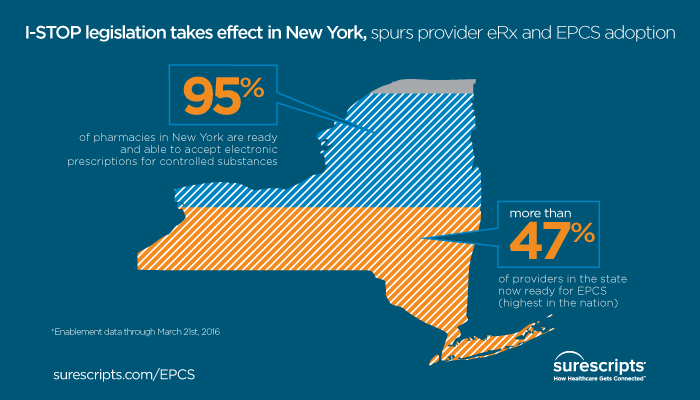Electronic prescribing is a first line defense for combating rampant prescription fraud and abuse in the nation today. And in New York, both prescribers and pharmacies have embraced its capabilities in order to make a difference in the fight against opioid abuse while ensuring patient safety and privacy, care quality, and process efficiency remain at the forefront.
A year after New York delayed its enforcement deadline for I-STOP – legislation that requires all prescriptions in the state, including controlled substances, to be transmitted electronically – the mandate has officially taken effect. On the pharmacy side, 95 percent of pharmacies in New York are ready and able to accept electronic prescriptions for controlled substances. Meanwhile, the state’s providers have done a tremendous job stepping up to the plate, with the number of prescribers enabled for electronic prescribing of controlled substances (EPCS) skyrocketing by an impressive 28 percent since February, with more than 47 percent of providers in the state now ready for EPCS. Put another way, 68 percent of active e-prescribers in New York are also enabled for EPCS, which significantly outpaces the national average of 14 percent nearly five times over. And even more impressive is that those providers who are enabled are actively utilizing the technology, with 37 percent of all EPCS transactions nationwide coming from New York.
In response to I-STOP – and the need to combat the country’s opioid abuse epidemic – the recent rise in EPCS enablement has been made possible because of EHR vendors’ certification of the technology, which is a necessity in order for prescribers to use the technology. Currently, EHRs serving 96 percent of prescribers in New York are certified for EPCS.
As we look beyond New York, there seems to be misinformation and confusion contributing to the slow rate of adoption nationwide. We are often asked to explain both the process for becoming enabled and the technology requirements, including necessary software updates and DEA third-party audits for vendors. But becoming EPCS enabled is much simpler than many might think. Providers can find step-by-step instructions at getEPCS.com, including information on required EHR software updates, prescriber ID proofing, credentialing for secure two-factor authentication, and setting secure access controls.
In 2015, we achieved two major milestones in the fight against prescription fraud and abuse, first with EPCS becoming legal nationwide, and second with the implementation of New York’s legislation. But there is more work to be done to address this nationwide epidemic. Patient safety, public health and prescriber efficiency must continue to be the primary drivers of technology adoption, and New York’s strong push for e-prescribing and EPCS enablement over the past year can and should be looked at as a case study of success for the rest of the country to follow.
Please visit getEPCS.com for more information and be sure to follow @Surescripts for the latest news, updates and educational resources on e-prescribing and EPCS adoption.



 Dean Riggott Photography
Surescripts
Dean Riggott Photography
Surescripts